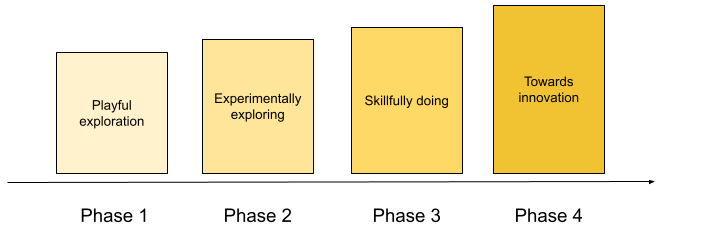The Purpose of design
The purpose of implementing Design in primary school is to guide students in the overall management of design thinking and creative process. Design by nature is a transdisciplinary subject in which activities based on expression, design, and technology are carried out. This may include independent or community designs, manufacturing, and evaluation of one’s own or a collaborative craft process. Designing and crafting is an exploratory, inventive, and experimental process and it implements an open-minded range of visual, material, technical and manufacturing solutions. In Design, students learn to understand, evaluate and develop various technological applications, and to use the learned knowledge and skills in everyday life. The crafting develops students’ spatial perception, tact, and hands-on activities that promote motor skills, creativity, and design skills. Teaching strengthens the preconditions for versatile work. The importance of design is in the long-term and innovative work process as well as in the experience that strengthens self-esteem and produces pleasure.
Teaching emphasizes students’ different interests and emphasizes community activities. The starting point for the design is a holistic examination of various broad-based themes that naturally transcends subject boundaries. Knowledge of the surrounding material world creates the foundation for a sustainable lifestyle and development. This also includes students’ own spheres of life, local cultural heritage, and the cultural diversity of the community. The Design raises ethical, conscious, participatory, knowledgeable, and enterprising citizens who value themselves as creators and have the skills to express their handicrafts and the desire to maintain and develop a maker culture.
The learning continuum of craft education from early childhood to upper primary
The Design learning pathway progresses from getting to practice and eventually applying knowledge and skills.

Teaching Design is a continuum where understanding, knowledge, and skills gradually deepen. The planned learning path can extend in the IB continuum schools from the early years to the MYP and DP Design. The goal of teaching design and craft is to manage the entire design thinking process, which includes getting to know, practicing, and applying various product design processes and skills. The entire design thinking process consists of brainstorming, innovation, design, making, and evaluation.
Phase 1 – Play-based explorations
In the field of early childhood education, the teaching of Design focuses on the child’s holistic learning. Activities include playing, moving, exploring, doing different tasks, expressing oneself, and arts and technology-based activities.
Phase 2 – Experimentally exploring
In phase 2, Design teaching supports growing up as a learner by creating a foundation for students’ positive perceptions of themselves as learners and schoolchildren. In addition, the aim of teaching is to develop skills for later work and learning. The learning challenges of design thinking and teaching guide students to become familiar with a variety of materials, craft tools, and equipment. With these, students practice cutting, pasting, joining, shaping, and machining materials as appropriate. The design emphasizes the practice of brainstorming and basic motor skills, as well as experimental acquaintance with design and various materials.
Phase 3 – Skillfully doing
In phase 3, they develop as learners by deepening the knowledge and skills learned in Primary Years Programme. In addition, the aim of teaching is to develop metacognitive, learning to learn, skills and to identify the student’s own study methods. Design and learning challenges guide students to practice managing the entire design process through a variety of their own and shared products and designs. The implementation uses a wide range of handicraft manufacturing techniques, tools, machines, and equipment. Students practice their design skills and strive to make a product or work on their designs themselves.
Phase 3 emphasizes the development of students’ design skills, creativity, and diligence, as well as long-term and safe practice of the skills. In addition, emphasis is placed on the application of design and learned skills in one’s own and joint collaborations, as well as the documentation and critical assessment of one’s own work.
Phase 4 – Towards innovation
In phase 4, the design supports community growth by deepening the knowledge and skills learned from a previous learning path. In addition, the aim is to support students’ individual development, responsibility, and interests connecting with the PYP exhibition. The ways of working and the diversity of learning environments aim to strengthen students’ motivation through authenticity and creativity. The planned design challenges guide students to make a variety of innovative, high-quality and functional, ecologically and ethically sustainable products or works in an entrepreneurial way. Tools, machines, and equipment are used in a variety and purposeful manner.
In phase 4, the design emphasizes students’ ability to innovate, responsibility, and familiarity with technological and cultural developments. In addition, emphasis is placed on analyzing the usability of products and the use of various technologies to support design, construction, and documentation.
Design Process
There are many different visual representations for the design process, most notably the Stanford d.school‘s model.

https://www.nuevaschool.org/about/notably-nueva/design-thinking
An example of a school that implements design thinking is the Nueva School
“In the lower school, students gain hands-on experience with design, engineering, and computer science through projects integrated into their classrooms as well as opportunities to engage with the I-Lab faculty both inside and outside of the Hillsborough I-Lab.
Design thinking is integrated into the lower school curriculum and projects in ways that are developmentally appropriate for each age group. As early as PreK and across the grades, students cycle through the full process, and zero in on a particular element (e.g., brainstorming, growing their repertoire of skills). In the fourth grade, using all of the skills they’ve learned throughout their time in the lower school, students embark on a full-scale, 16-week design thinking challenge to build an LED lamp for someone in their lives who needs light.”
“Design thinking is a collection of techniques and mindsets that enable people to identify underlying needs through empathy, to harness and develop their ability to generate ideas, and to actively seek feedback. By flaring and focusing, people discover a path through complex, difficult problems, which transforms them into fearless and effective changemakers.”
Kim Saxe
FOUNDING DIRECTOR OF THE INNOVATION LAB
The design process in the primary is formed into entities that contain current and varied learning tasks for different grades. The content implements the knowledge, understanding, and open application of different materials and work methods by hand, utilizing what has been learned in other subjects and learning environments. The key areas that a primary design process should emphasize are
Ideation
Design
Experiment
Making
Documentation
Evaluation
Primary Design Process
- Ideation – Get acquainted with different starting points and utilize one’s own multisensory experiences and experiences, as well as observes and analyzes objects, the built and natural environment to develop new ideas.
- Design – Make a plan for a product or work and develop it if necessary. Experiment with different materials and working techniques to develop ideas into a product or design.
- Experiment – The properties of the materials and the operating principles of the most common tools and equipment needed to make crafts are studied and experimented on.
- Making – A variety of individual and community products and designs are made, using a variety of craft manufacturing techniques, tools, machines and equipment. Learners utilize/follow a self-made plan.
- Documentation – The use of information and communication technology is introduced as part of brainstorming, design and documentation.
- Evaluation – Different ways of self- and peer review are provided as the process progresses. Learn to give feedback to other students.
Schools will need to create their own individual syllabus/continuum of these strands in order to create a comprehensive and transdisciplinary program that is able to connect with the learning that takes place in the homeroom and other subjects.







